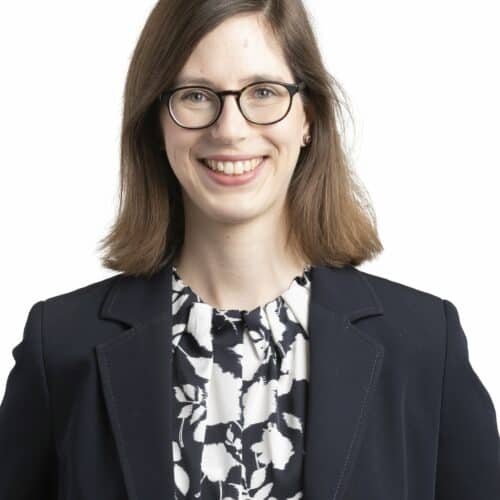Beatrice Korwisi holds an MSc in Psychology and is currently a PhD student in the Division of Clinical Psychology and Psychotherapy in the Department of Psychology at Philipps-University Marburg in Germany. She has been an IASP member since 2017 and attended her first World Congress on Pain in Boston, Massachusetts, USA in 2018. She is looking forward to the next IASP World Congress on Pain in Amsterdam and others in the future. IASP talked with her about her research and studying pain.
How did you get into pain science? Did you always know it was what you wanted to do or did you start somewhere else?
I first learned more about pain, and especially chronic pain, during my graduate studies in a course on behavioral medicine. I remember thinking “three weeks of talking about pain is quite a long time when every other topic gets only one week” when I had a first glance at the syllabus. However, I was fascinated by this topic shortly into the first lecture, and I would have been glad of even more lectures on it! It amazed me how pain brings together so many different fields – psychology, biology, medicine, among others. I knew I wanted to pursue my PhD in a field as multidisciplinary as pain. And luckily, Antonia Barke and Winfried Rief at the University of Marburg were looking for a PhD student to assist with the coordination of the IASP Task Force for the Classification of Chronic Pain just at that time. It was my dream project – combining the multidisciplinary topic of chronic pain with international cooperation. Today, nearly four years later and nearing the completion of my PhD, I am grateful for this opportunity. And, of course, I am looking forward to many more years in the pain field.
What topics does your current research/ clinical practice cover? How does this affect the public?
My current research focuses on the evaluation of the new ICD-11 chronic pain classification. I have been assisting Antonia Barke with coordinating the process of development of the classification since 2016. In 2019, I took over as the scientific coordinator when Antonia transitioned jobs. The classification was developed by an international IASP Task Force (the IASP Task Force for the Classification of Chronic Pain), chaired by Rolf-Detlef Treede (Mannheim, Germany) and Winfried Rief (Marburg, Germany). It has been implemented in the ICD-11, which will come into effect in January 2022. We hope that this classification will improve the situation of patients with chronic pain worldwide by providing clinically useful diagnoses, and thus contributing to improved communication, documentation, data collection, and access to multimodal treatment. Chronic pain will become more visible, for example in large epidemiological studies on its prevalence rates, impact, or costs of different diseases. Fostering basic as well as clinical chronic pain research will be another result of the new clearly defined and operationalized diagnoses.
Who is or was your mentor? Who inspires you? How has their research/clinical practice impacted yours?
Antonia Barke, who is my PhD supervisor, has been a very important mentor to me. She has been encouraging me from the beginning of my time as a PhD student and has always believed in my research ideas, helping me to figure out how to make these ideas possible. I learned from her how to coordinate a large Task Force, thus also developing some important networking skills. I would also like to mention Winfried Rief here, who is the professor of my lab and has been involved in my research projects as well. I have learned a lot from him, and I am very grateful that he supported my research projects to become a reality.
What has been your biggest professional challenge/obstacle thus far and how did you handle it/overcome it?
I think my biggest professional challenge so far has been adapting to academia during my time as a PhD student and coordinator of a large Task Force. Often, so many different things need to be done at one and the same time – deadlines approaching, writing reports and manuscripts, coordination, and administration, to name just a few. Especially in the beginning of my time as a junior researcher, this felt overwhelming from time to time, not knowing where best to begin. Coffee has certainly been helpful in the process. I also work a lot with my optimized to do lists to structure and prioritize my workflow. But what has been most helpful was the exchange with my mentors, and I can encourage all young scientists to take advantage of the opportunity to learn from their experiences.
Why did you become an IASP member?
I became an IASP member after having worked with the Task Force for a couple of months. I wanted to be a part of this great pain community, not merely looking at it from the sidelines. I value being an IASP member for the great network this provides me. The regular newsletters keep me updated on what is happening in the pain field. I have also recently joined my first PRF Webinar, and it was very enriching.
What do you do in your spare time? Do you have any hobbies, other pursuits, or hidden talents?
I love being outside and enjoying nature. There is no better place to relax and recharge my batteries than the woods. Having my camera and tripod at hand to capture these moments makes my outdoor time perfect.
Interested in becoming a member of IASP?
With your IASP membership, you gain access to:
- PAIN Journal
- Pain Education Resource Center (PERC)
- Access to 24 Special Interest Groups (SIGs)
- Online Career Center access
- Discounts on World Congress
- Network of thousands of pain researchers from around the world!
Membership dues are determined by income, the rates of membership can be found at this page of our website.


